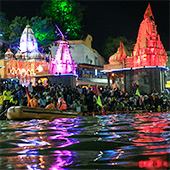Ujjain is the largest city in the Ujjain district of the Indian state of Madhya Pradesh. It was the most prominent city on the Malwa plateau of central India for much of its history. It emerged as the political centre of central India around 600 BCE. According to Puranas Ujjain was called as Avantika and was famous for its beauty and its devotional epicenter where students went to study Holy Scriptures.
As per legend a King called Chandrasena, who was a pious devotee of Lord Shiva, ruled Ujjain. His Kingdom was attached by neighbouring Kings Ripudamana and Singhaditya to take over the treasures and they were successful. The king Chandrasena prayed to Lord Shiva for the dismissal of his enemies, upon hearing the pleas of his Devote Lord Shiva appeared in Mahakala form and destroyed the enemies of the King. Ujjain is situated on the eastern bank of the Kshipra River, which is a perennial river. It rises in Ujjain and flows north towards the Malwa plateau to join the Chambal River. Legend says that once Lord Shiva went begging for alms using the skull of Lord Brahma as the begging bowl. Nowhere does he manages to get any alms. Finally, he went to Vaikuntha and asked Lord Vishnu for alms, in return Lord Vishnu showed his index finger, which enraged Lord Shiva. Lord Shiva took his trident and cut off Lord Vishnu’s finger, it started bleeding profusely. The flow of blood became a stream and finally a river Shipra. Ancient Hindu texts suggest that the Shipra originated from the heart of Varaha, Lord Vishnu’s incarnation of Boar.
In Ujjain, the Mahakaleshwar Jyotirlinga is one of the most famous Hindu temples dedicated to Lord Shiva and is one of the twelve Jyotirlingams, which are supposed to be the most sacred abodes of Lord Shiva. It is located on the side of Rudra Saga Lake. The Presiding deity Lord Shiva is in the Lingam form and is believed to be Swayambhu. (Deriving currents of power from within itself). The Mahakaleshwar is known to be Dakshinamurthi, which means the idol is facing south.
Sultan Shas-Ud-Din Iltumish destroyed the temple complex during the raid in 1234-1235. The present structure was built by General of Srimant Peshwa Baji Rao and Chhatrapati Shahu Maharaja of the Hindu Pad Padshahi---Srimant Raanojirao Shinde Maharaja (Scindia) in 1736 AD.
Kumbhamela can’t be experienced with the words. It is an event that has no comparison; there is nothing in the world anything like it. Trying to understand it is difficult, one has to witness it to believe in it. It is a varied experience for each individual.
In 1895 Mark Twain attended the Kumbhamela and wrote about his experience- “It is wonderful, the power of a faith like that, that can make multitudes upon multitudes of the old and weak and the young and frail enter without hesitation or complaint upon such incredible journeys and endure the resultant miseries without repining. It is done in love, or it is done in fear; I do not know which it is. No matter what the impulse is, the act born of it is beyond imagination, marvellous to our kind of people, the cold whites”.









